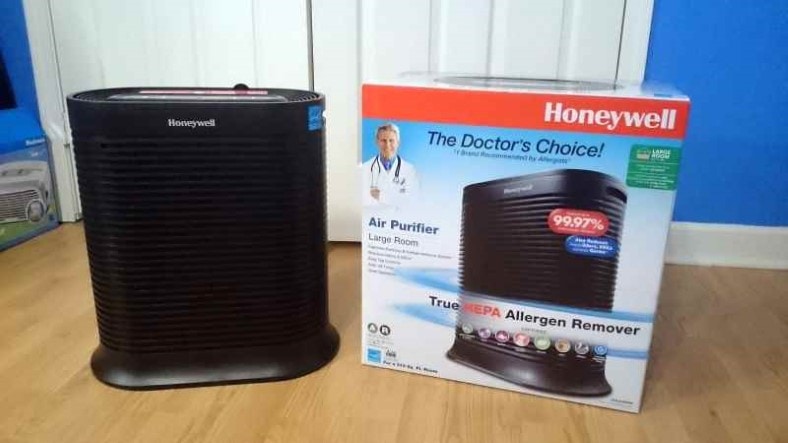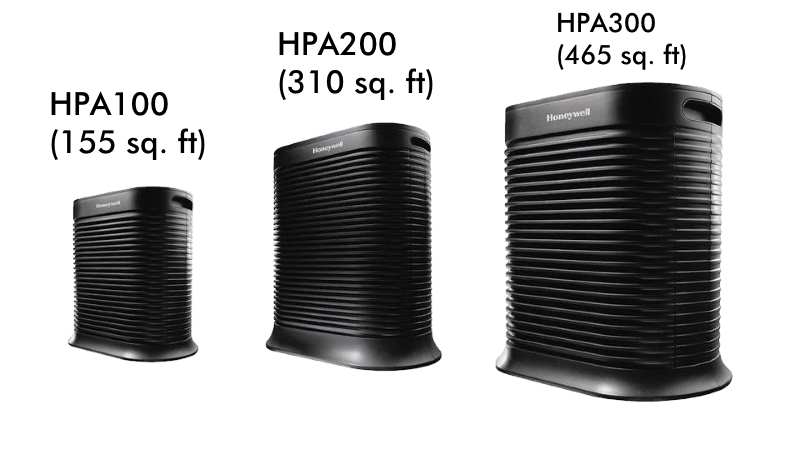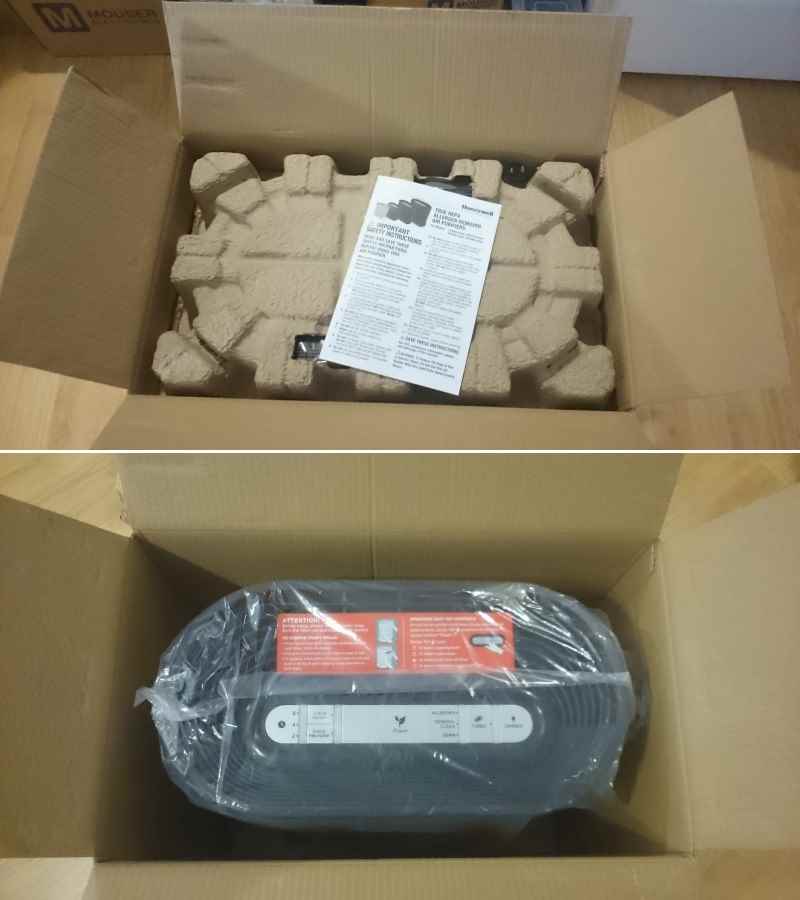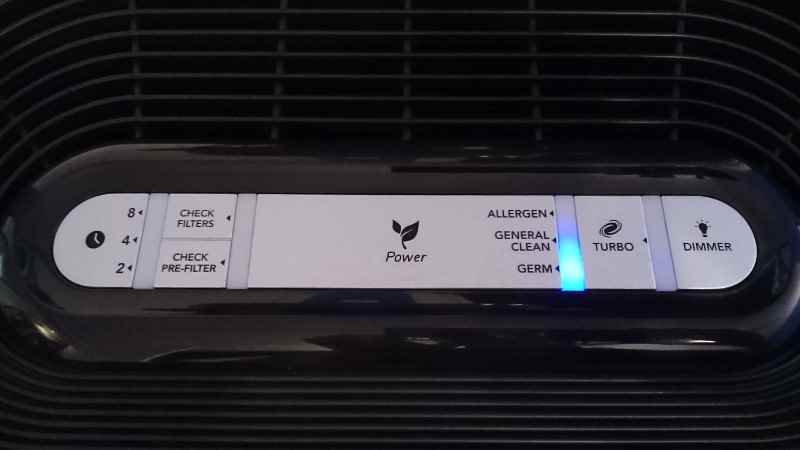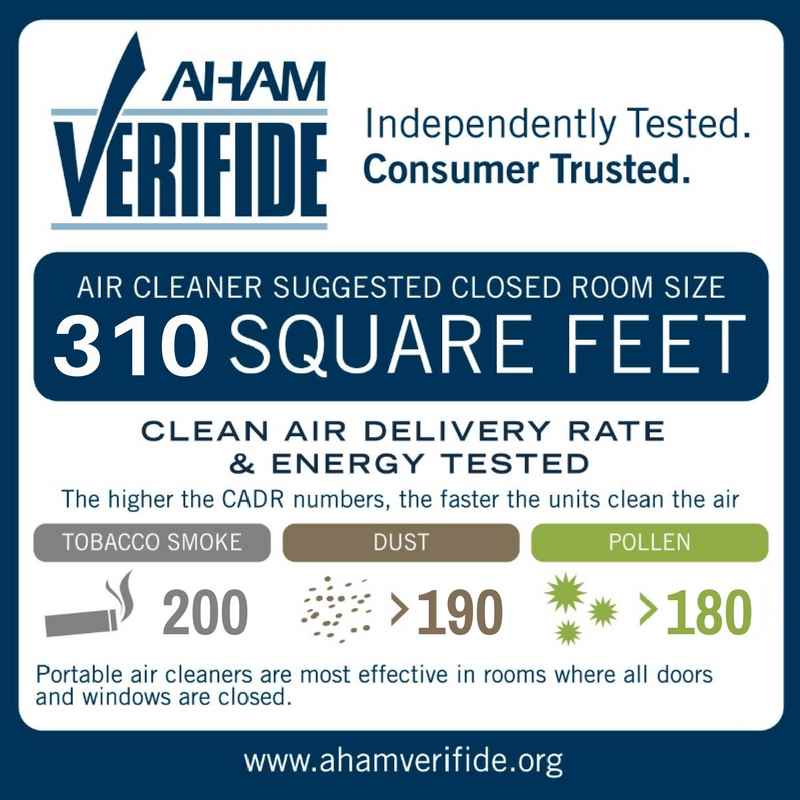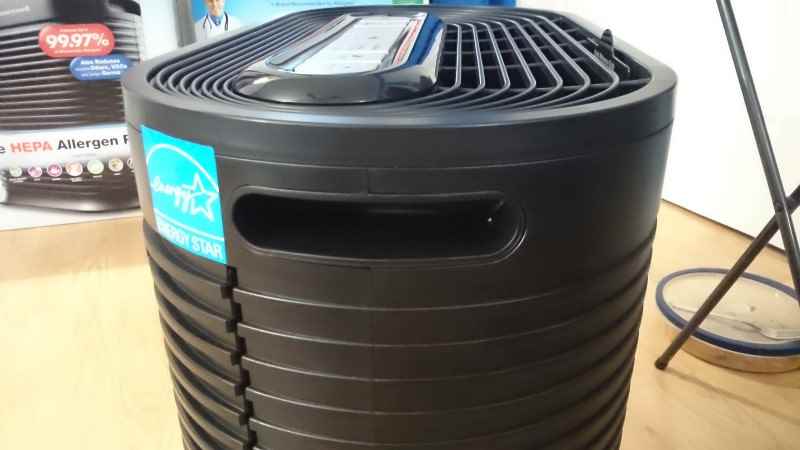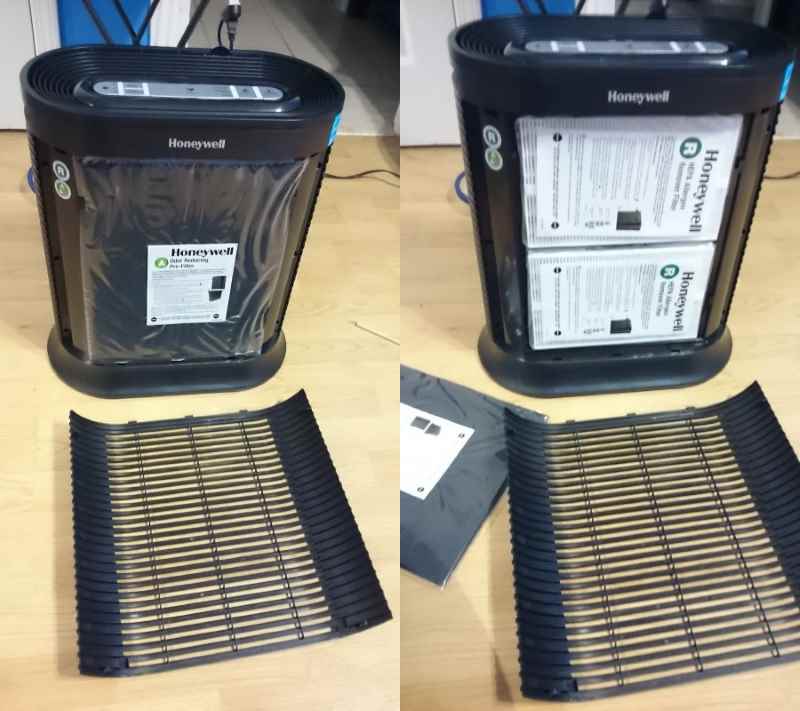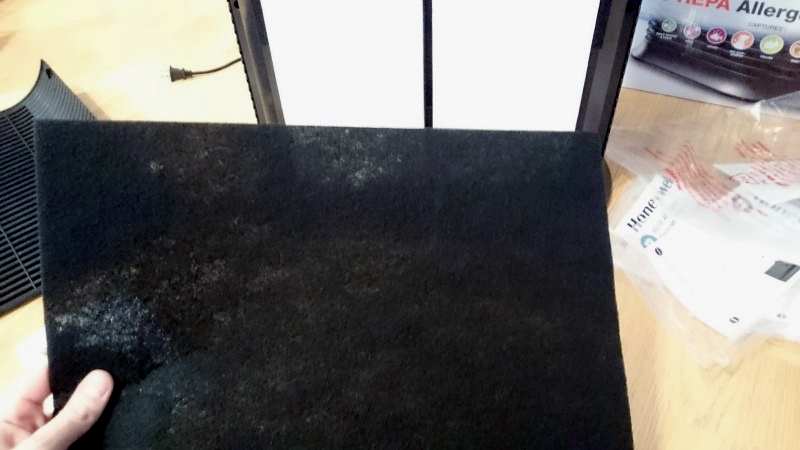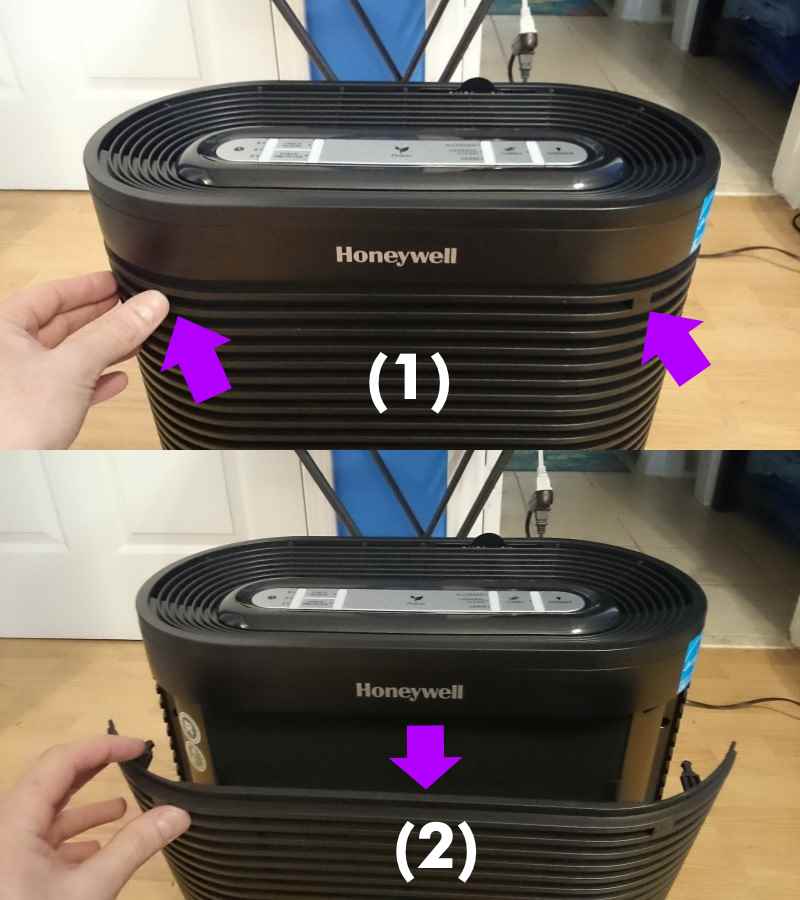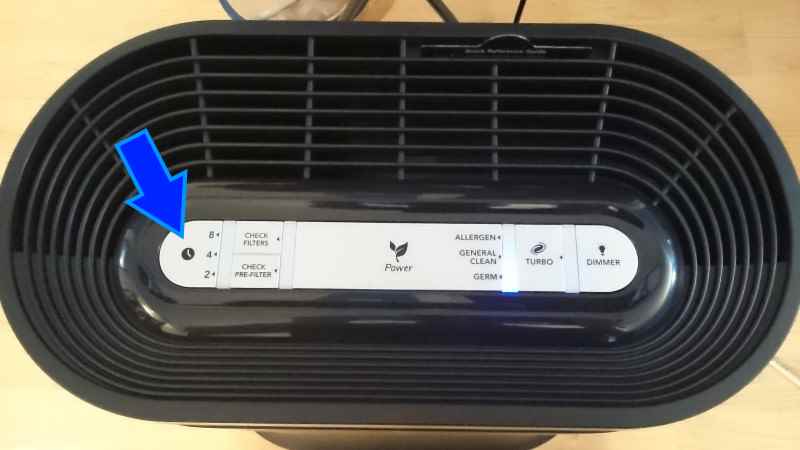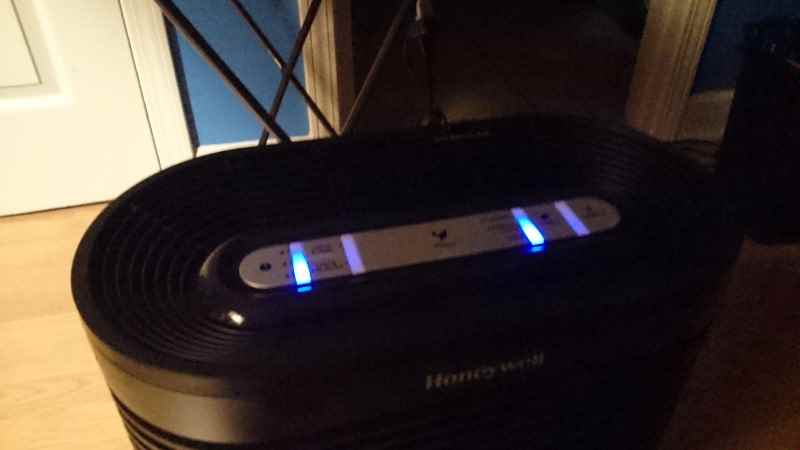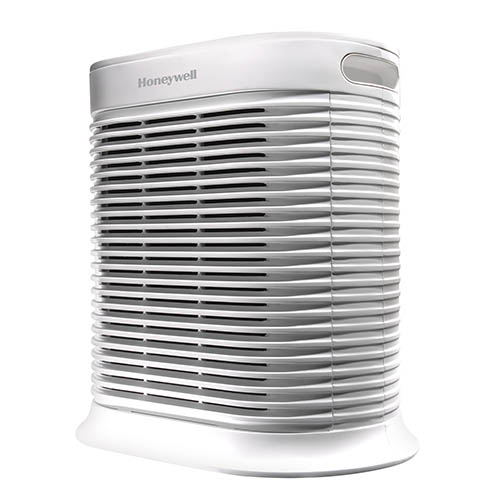Looking for a good purifier? I’ve been there myself. In my honest and real Honeywell HPA 200 review I’ll go into a lot of detail and specs that you need to know.
There are so many choices out there today that it can seem hard to sort them all out. I’ve recently begun finding out more about the Honeywell line of air purifiers and why they’re so popular.
Read on to see what I found and learn more!
Contents
- Getting to know the Honeywell HPA200
- Unboxing the HPA200 – First impressions
- New user label
- Checking out the HPA200’s controls
- Specifications
- Carrying & moving the purifier
- Air cleaning ability & performance
- What kind of filters does it use?
- Filter life and costs
- Is it safe? Can the Honeywell HPA200 cause headaches?
- Using the auto-off timer feature
- The owner’s manual
- Noise levels during use
- Brightness levels in a dark room
- Review summary
Getting to know the Honeywell HPA200
The HPA 200 is part of a family of 3 very popular models from Honeywell. They share a similar design and are available in different room size ratings. I like the consistency between them.
The HPA200 is one of the “middle siblings” in a family of similar products from Honeywell. It’s suggested room coverage size is about 310 square feet (which is a room about 16 x 19 ft in size). It’s considered a large room air purifier, although there’s no harm in using it in smaller rooms as well.
The HPA200 and other HPA models use 2 types of filters: true HEPA filters and a single separate pre-filter. Both are replaceable and the filters are shared between them – which is kind of unique – they use 1-3 of the same filters depending on the model.
The air cleaning process works using a “true” HEPA filter which is highly efficient at removing nasty allergens, dust, and smoke particles down to microscopic sizes. The pre-filter captures odors and larger elements like hair and bigger dust.
A single (and powerful) fans draws in air which is filtered and then blows outward back into the room at the top. It has a single vent directly next to the control panel.
It’s a big purifier at about 18.9″ (47.9 cm) but it’s actually shorter than come competitors like the GermGuardian AC5000E.
Unboxing the HPA200 – First impressions
Packaging
I picked up my HPA200 and got to unboxing. I was pleased to see the same consistent quality I saw with the larger HPA300, its bigger brother for extra-large rooms. The box is nicely designed and features the purifier’s features and benefits, along with the model of replacement filters needed.
How’s the build quality?
The unit looks good and is well put together. The body is made of ABS plastic satin (low-gloss) finish. Unlike some other products on the market, I didn’t get an impression of cheapness or it being flimsy. Just as expected, quality is consistent throughout the Honeywell HPA series. No unusual gaps or assembly problems were found, either.
I removed the good packaging (recyclable cardboard material) and started checking out the assembly and construction quality. It’s a step I always take to understand better the “big picture” when it comes to evaluating an air quality product.
You can tell a lot from how something feels in your hands and just like with car, how well it’s put together.
I looked it over well and found no issues with it. Quality and appearance are good. No noticeable gaps where panels fit together and line up. Also, the control panel looks good, with a nice brushed metal silver finish and well printed labeling.
The HPA 200 isn’t exactly small at almost 19″ tall and about 20 lbs (9 kg) in weight, but it’s surprisingly easy to move around. Changing locations for use in your room won’t be an issue.
New user label
After removing it and unwrapping it, the first thing you’ll find is a “new user” label on top, immediately above the controls.
It’s a nice touch, and clearly explains getting the purifier ready for use and also basic control operation. I don’t recall seeing this on other brands before and I definitely like it.
One important thing to know is that the filters must be removed from their plastic bags and re-installed before using the purifier. This is noted on the label as well.
Built-in quick reference guide
Near the controls there’s a small rounded tab sticking out. Pulling it up reveals a great little quick start guide. It’s a nice touch and very handy – you can’t lose it! It also features Honeywell’s customer support phone number.
One little surprise I didn’t expect to find was the guick start guide that’s built into the purifier’s top section. Located above the control panel (on top, near the outer edge) is a small tab that can be pulled.
Doing so reveals a small plastic sheet with basic operation information and the company’s customer support helpline.
I think it’s great and it’s reflective of both the HPA200 and the rest of the Honeywell air purifier line. For people who lose manuals easily or new users, it’s a great way to never have to worry about instructions.
Checking out the HPA200’s controls
The HPA200 shares a similar control panel with the smaller HPA300 and HPA100 models
It uses touch-sensitive controls that allow changing cleaning modes, activate the Turbo speed feature, set the auto-off timer, and dimming the control illumination.
I did notice on occasion that the panel might not have detected that I touched it, but ordinarily it wasn’t an issue. Perhaps it’s due to the (light) force I used when using it, but overall it’s not a real issue. In my opinion it’s not a bother.
How do the controls work?
By lightly touching the control panel near the labels for various functions the operation state for each feature rotates through the available functions.
For example, touching the clock symbol area turns on the 2 hr auto-off timer. Touching it again moves the selection to the 4 hr option, and so on. When Turbo mode is turned on, touching it again restores the previous fan mode in use
Changing cleaning and other modes
3 basic modes of operation are provided:
- Germ
- General
- Allergen
The various modes are really easy to control and you simply repeat touching the panel to rotate through the various settings.
Cleaning mode: Off -> Germ -> General -> Allergen -> Off.
The dimmer also rotates the brightness level of the blue indicator lights used to display current modes. Touching the dimmer control moves though: Full -> Medium -> Low -> Off -> Ful.
Similarly, the auto-off timer is initially off and can be rotated through the 3 time options available: Off -> 2 hours -> 4 hours -> 8 hours -> Off.
In my opinion, the controls are very easy to use. For people who are normally are more comfortable with switches or push buttons, it may seem odd at first, but it’s incredibly easy to get accustomed to. I’m sure you’ll like it!
However, I don’t understand why Honeywell has named the 3 fan (cleaning) modes as Germ, General, and Allergen. After using it, it seems they’re essentially just low, medium, and high fan speed modes. Unfortunately, the manual doesn’t differentiate these in detail.
Specifications
- Room size rating: 310 sq. ft (large room)
- 3-mode/speed fan control: Germ, General, Allergen
- Turbo high-speed fan mode for rapid cleaning
- True HEPA filters (uses 2 Honeywell Type R filters)
- Smoke CADR rating: 200
- Dust CADR rating: 190
- Pollen CADR rating: 180
- Touch control panel
- Quick start guide built into body
- 2, 4, and 8 hour auto-off timer feature
- HEPA filter replacement reminder
- Pre-filter replacement reminder
- 5-year limited warranty
- Replacement HEPA filter: HRF-R2 (2 filters)
- Replacement pre-filter: HRF-AP1
- Weight: 20 lbs (9 kgs)
- Cord length: 6 ft.
- Control location: top
- Size: 17.72 x 10.05 x 18.86″ (45 x 25.5 x 47.9 cm)
CADR ratings
The HPA200 is a larger purifier with a powerful fan so it’s not surprising to see that its Clean Air Deliver Rate (CADR) is higher than some of the competition. The CADR is a laboratory-proven way of demonstrating how quickly an air purifier can clean the air in a room – the higher the score, the better.
The HPA200’s AHAM ratings label. Unlike some of the other products sold today, Honeywell has had actual demonstrated testing performed to rate it. It’s a great way to know you’re getting an effective purifier with proven results.
The Association of Home Appliance Manufacturers (AHAM) provides home air quality testing for air purifier manufacturers. Air purifiers in particular are rated according to dust, smoke, and pollen cleaning efficiency. A higher number is better.
In general, 300 and above is excellent while 100 is ok. Below 100 is poor. As you can see, the HPA200 does well for its size at close to 200 for each of the 3 major filtering criteria used for testing.
You’ll be getting a good purifier that cleans large rooms well and small rooms even better!
Carrying & moving the purifier
The HPA200 features a carrying handle area on both sides near the top. Using these, it’s easy to move it around as needed by placing your fingers inside with 2 hands. Just pick it up and move it around – very convenient!
Despite the HPA200 being rather big in size, it’s actually very easy to move around. Don’t let the weight or size intimidate you at all.
Both sides, near the top, have a place to put your fingers to allow easily moving the purifier from place to place. It’s a great feature and I didn’t fully appreciate it until I tried it. A nice touch that is shared by some of the GermGuardian products as well.
At first glance I to myself, “Oh boy, this one’s pretty big and will a pain to deal with” but I was completely wrong. I’m happy to report that despite the size and how it seems really big in your mind, it’s actually quite easy to deal with.
Air cleaning ability & performance
The HPA200 does great at removing problem-causing airborne particulates. For me personally, dust is an issue. When testing the purifier I was able to greatly reduce the dust in my room and home. Pictured: (Left) Fresh, new HEPA filters and (right) used filters after many months of cleaning the air. It works well and I was very happy to have tried it!
Air purification in my home is especially important to me as if you’ve read my About Me page you know how much I love clean air. I firmly believe we’re all entitled to it.
Dust has kind of been a thorn in my side for some time, but after trying the GermGuardian AC4825 I saw how much of a fantastic impact a good air purifier could have. I’m very happy to say that the HPA200 does great here as well!
The Turbo mode is a bonus that lets you accelerate how quickly your room gets cleaned. I didn’t really understand how good it was at first, but let me tell you that after a few hours of using it, I appreciated it more and more.
While there are other products with somewhat similar cleaning abilities almost none of them have a high-speed Turbo feature like the Honeywell offers.
What kind of filters does it use?
Right out of the box, the HPA200 needs to be set up with filters by removing them from their plastic protective bags. Left: the pre-filter (Honeywell HRF-AP1 model). Right: behind the pre-filter, the HPA200 has 2 Type R filters (sold as a package called HRF-R2). Unlike other brands, these are not made as a 1-piece filter assembly. You’ll need to remove them from their bags before using the purifier.
The Honeywell HPA purifiers use High Efficiency Particulate Air (HEPA) filters as well as an odor reducing pre-filter for large elements and odors. They’re commonly available and the purifiers are designed to use the same filters but in different quantities.
HEPA filters are made of very dense material and are very efficient for cleaning the air. They can remove 99.97% of nasty elements in your air down to an incredibly small 0.3 microns in size. (A micron, or micrometer, is 1/1,000,000 of a meter in size).
For example, the HPA200 uses 2 Type R HEPA filters, the HPA300 uses 3, and the HPA100 uses 1. All three share the same HRF-AP1 pre-filter. It makes filter replacement less confusing and easier to deal with.
Opening one of the Type R HEPA filters before installing it and using the purifier. The included filters are made of a soft but dense material that filters out an amazing 99.97% of unwanted particles in the air. These particles cause allergies, sneezing & sniffling, and much more.
Installing the filters
After unboxing your new purifier and removing the filters from their sealed plastic bags, you’ll need to re-install them in the purifier. With the front grill removed (see above for how to do that) it’s simply a matter of pushing them back into place.
The purifier is shipped with 2 Type R true HEPA filters which you’ll need to remove from their plastic bags and insert into the front of the purifier. It’s really easy to do and only took me a few moments.
Installing the odor reducing pre-filter, which is simply placed over the HEPA filters and into tabs on both sides in front of them. It’s very quick and painless. After placing it into place, you insert the front grill (insert the grill’s tabs into slots at the base) and then snap-click the retaining tabs into place at the top.
The odor reducing pre-filter that’s included is basically a large square section of a filter material without a rigid frame attached. It’s very easy to insert for the first time or to replace: just place it in front of the HEPA filters and insert the edges into tabs on both sides. Then close the grill over it.
Here’s the basic list of air contaminants the HPA200 can remove:
- Pet dander
- Pet hair (thanks to the pre-filter)
- Dust mite allergens
- Pollen
- Dust
- Home construction particles
- Smoke residue
- Smoke odors
- Chemical and organic odors
The pre-filter section is a less dense & thin section covering the active carbon filter. Its job is to first capture larger items in the air like pet hair, dust, and so on. The active carbon filter traps odors and other chemical substances in the air.
Together, they work well. As I’ve mentioned in my other posts, I have a problem with dust and HEPA purifiers have really helped a lot.
For odors, though, you need to understand that the Honeywell purifier will help, but it isn’t an instantaneous solution. It takes time for it to cycle the air and remove odors…but it definitely helps!
Opening the front cover/grill
In order to replace filters or to initially get your purifier set up, you’ll need to remove the front grill.
On the HPA3\200 this is done by slightly pressing marked points on both the left and right sides as indicated. These are snap-click retainers that hold tabs on the grill in place. The grill has 2 tabs on the bottom which hook into slots before the grill is moved upward and snapped into place.
What I found out is that it’s very easy to do. However, if you move the purifier and even lightly touch the grill near the top it has a tendency to become loose and the grill needs to be re-seated.
This is a pretty small annoyance, but it’s something to bear in mind.
Filter life and costs

This is because using the pre-filters both extends the life of the more expensive HEPA filters but also pre-filters have a limited life for absorbing odors and other chemical substances in the air.
This is in contrast to others which average 6 to 8 months before recommended replacement, so that’s actually very good.
Replacing both HEPA filters will cost around $27 dollars or so for a 2-pack made by Honeywell. The pre-filter averages somewhere close to $6, so it’s really a good deal in that case.
While $27 or so may sound like a bit of money, it’s actually not bad at all as many other products cost close to $30 for 6 months or so replacement.
Filter replacement reminders
What sets the HP200 apart from other purifiers is that it features separate replacement reminders for the HEPA and pre-filter elements. It’s a unique feature that few products have.
After a replacement reminder comes on you can check the filter and clear the reminder by pressing the lighted button and holding it for about 2 seconds. It will clear and the reminder will be reset.
Note: you can also replace filters before the reminder occurs and reset the reminder ahead of time, according to the manual. With the unit turned off, press and hold each button separately for 5 seconds. The indicator light will illuminate. Then press and hold that indicator light until it goes off. After this, the particular reminder will be reset to its “clean” initial state.
Is it safe? Can the Honeywell HPA200 cause headaches?
As I’ve discovered that many people search for an answer to this question, I wanted to cover this topic in my review as well. As I explain more in this post, an air purifier based on filtering the air doesn’t produce any emissions.
The HPA200 simply filters the air – it doesn’t add anything to it or produce harmful or irritating by-products. It will not cause headaches. It’s perfectly safe and there are NO health concerns to worry about.
Using the auto-off timer feature
The auto-timer shuts off the purifier after 2, 4, or 8 hours have passed. It’s very easy to use. Just touch the control and set it to one of the 3 hour settings (2, 4, or 8 hours) and it will turn itself off automatically.
In order to use it, simply touch the clock symbol to rotate through 2, 4, or 8 hour options. Doing so a 3rd time will turn it off again. I tested this when going to sleep and it worked well.
I like it – what a great option to have before bedtime. No need to worry about having to get up in the middle of the night to turn it off!
The owner’s manual
The owner’s manual is only about 8 pages in length for the English section, but it’s very straightforward and clear. Well-written and concise, it covers the most important basic information you need to use and maintain your purifier.
Additionally, one of the best things is that it makes it easy to find the customer service telephone number if you need it!
If you’d like to read more before buying, you can view or download the HPA200 owner manual here.
Noise levels during use
For such a big purifier, noise levels seemed to be very reasonable for Germ, General, and Allergen modes! Germ mode was especially quiet and in fact as low as some of the small or medium room purifiers I’ve tested!
After trying the purifier, it seemed as if those 3 operational modes corresponded to low, medium, and high respectively.
Turbo mode is much louder and of course isn’t suitable for sleep time. But it’s a great feature to have when you can run it full-speed if the noise won’t be too much for you.
Volume measurements
I used a No products found. to measure volume levels. I tested the volume levels at 1 meter (3.28 ft) from the purifier.
| Measurement/Mode | Volume (dB) |
|---|---|
| Off (Room noise) | 39.3 |
| Germ mode | 46 |
| General mode | 50.3 |
| Allergen mode | 55 |
| Turbo mode | 59 |
Turbo speed mode is definitely a bit loud and is not suitable for times when you’re close to it. As far as the others are concerned, it’s almost the exact same (relatively low) as smaller purifiers I’ve reviewed before.
Honestly, the noise level in General mode was almost unnoticeable with music or YouTube videos playing. I completely forgot I had turned it on!
Originally I thought the 3 main modes would be much worse in terms of noise. It’s a pleasant surprise to use it and not even notice it’s running!
Brightness levels in a dark room
I’m very concerned about how bright the illumination of air purifies are. I’m very sensitive to both light and sound when sleeping. The HPA200 does have blue LED backlighting for the controls, however, it wasn’t terrible. In a completely darkened room the backlighting did light up the room a bit, but I able to eliminate this thanks to the Off mode.
Honeywell has built-in a nice little dimmer control (accessed by simply touching the Dimmer button area) for 3 levels of control illumination: Medium, Low, and Off. Although the backlighting is not bright in my opinion, in a darkened room it was a different story. The illumination was still a bit much for a smaller room.
The Off setting on the dimmer fixed this right away – it was a great feature to have.
You should have no concerns whatsoever about it keeping you awake at night even in the same room. If you’re sensitive to light like I am you can simply switch it to the Off setting. Very nice!
Review summary
After getting my hands on the HPA200 and getting a chance to really dig in, I have to say I’m pleased. It’s a high-quality air purifier with good performance that works well.
It’s not a “small” air purifier, but it does what it is supposed to: it cleans the air in large rooms well.
While I do have minor complaints, they’re negligible and are nothing that would keep me from recommending it to others. The filters are bit unique in that it uses 2 smaller HEPA filters rather than one larger one as other brands do, but it’s a minor detail that doesn’t affect anything.
Unlike the GermGuardian product line, Honeywell doesn’t offer a UV-C germ killing feature to use for reducing airborne microbes. I do consider that a disadvantage, as it seems like it would not be a large matter to add to the design.
I do wish the owner’s manual explained in more detail about the various cleaning modes, as to me they appear to be simply low, medium, and high in practice.
Again, these are all minor gripes compared to how great the performance and quality is. The HPA200 is easy to use and I enjoyed using it. It’s a great choice for anyone wanting a good purifier for their money.
Want to learn more? Then head over to find out why it's so popular and check the current price at Amazon.
Note: you can also find it in white, sold as the identical HPA204 model here.
Overall
-
Quality - 9.2/10
9.2/10
-
Value - 8.7/10
8.7/10
-
Ease of use - 9.7/10
9.7/10
-
Air cleaning ability - 9/10
9/10
-
Features - 8.5/10
8.5/10
-
Noise levels - 8.8/10
8.8/10
Well made and effective, the HPA200 is a great choice for large rooms up to 310 sq. feet. It's very easy to use and one of the best for your money.
The Honeywell HPA200 may seem a bit large and bulky, but it’s actually easy to move from place to place. The air cleaning ability is very good and works well in my testing. The touch-sensitive controls are intuitive and simple. Instructions are clear and easy to follow. Standardized replacement filters make maintenance very easy. Surprisingly quiet despite being powerful, in my tests it’s a very nice buy and well worth what you pay.
Pros
- High-speed Turbo mode for faster cleaning
- High CADR rating – great purification efficiency
- HEPA filters last approx. 12 months
- Odor-reducing pre-filter is inexpensive ($6 or so)
- Pre-filter can be replaced separately
- Carrying handles on both sides
- 5-year limited warranty
- Height is about the same as lower-capacity competitors (20″)
- Touch controls work well and are easy to learn
- Built-in quick start guide
- Customer support is good
- Good owner’s manual
- Auto-off timer shuts off automatically
- Low noise levels except for Turbo mode
- Filter replacement is simple to do
- Indicator lamp brightness is low for night use
- Good build quality, fit and finish are nice
- Filter performance is good, fresh air quicker
Cons
- Auto-off timer only adjustable in 2, 4 or 8 hours
- Manual doesn’t clarify the 3 main operational modes (Low, med., high?)
- No auto-sensing feature at this price level
- Germ-killing feature not available
